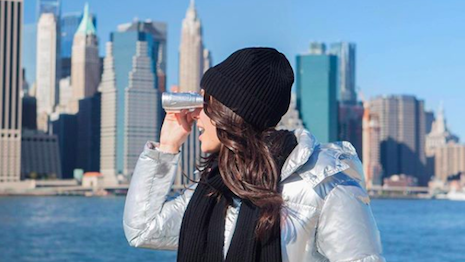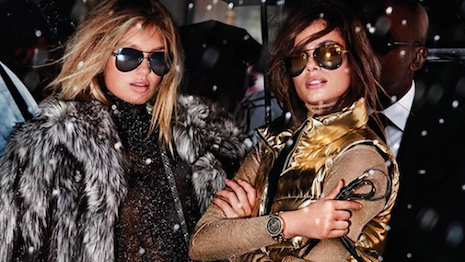 What does winter have in store for retail? Image credit: Bloomingdale's
What does winter have in store for retail? Image credit: Bloomingdale's
Cold spells and snowstorms are often considered a hindrance to retail. But with the right planning, retailers can position themselves for success even amid winter weather.
Retailers often strategize far ahead, making unexpected weather patterns a potential hazard to business operations as usual. In the wake of the bomb cyclone's path through the northeastern United States, what can retailers expect from future severe weather this winter?
"There is no single answer as the impacts will differ by retail sector and time of year," said David Frieberg, vice president of marketing at Planalytics, Philadelphia.
"The luxury sector is obviously driven more by discretionary purchasing and therefore the recent cold is a net negative," he said. "The luxury consumer is much more likely to delay their shopping trips until it is nicer out."
Stormy weather
Some degree of winter weather is beneficial to retail. In past years, mild winters have driven down demand for merchandise such as warm coats and boots, leading retailers to aggressively markdown seasonal merchandise to move it.
"In the peak shopping weeks of December even very cold weather tends to remain a net positive for many retailers as it gets consumers to seek out cold weather items while they're out shopping," Mr. Frieberg said. "Cold weather typically doesn't keep consumers from shopping in November or December -- it takes inclement weather such as snow, ice, etc. to keep consumers at home simply because they can't get out.
"Now that we're in January, the extreme cold can keep people in hibernation mode a bit more than in December," he said. "During the holidays people are going to shop, but in January it becomes easier to just stay in and put off a trip to the mall or a restaurant. Some of the spending shifts. Online gets a boost and ordering in becomes more appealing than going out to a restaurant.
"That said, the extreme temperatures also make items like heavy coats, gloves, hats, etc. a bit more of a 'need' than a nice to have and, as a result, we see some apparel-focused retailers benefit from a weather-driven bump in sales. But this will be more evident at discounters and mid-level priced retailers."
Cold weather is good for moving seasonal merchandise. Image credit: Moncler
Planalytics has found that during last week and this week, cold weather apparel in the Northeast has seen a 30 percent boost over the same time period last year.
However, while some cold and snow can drive sales of weather-appropriate attire, blizzards can often keep people away from stores. Depending on the severity of storms, retailers may also choose to close to keep employees and customers safe.
A Planalytics white paper produced in partnership with the National Retail Federation pointed out that even categories that do not seem tied to weather can see their sales altered by a snow storm or severe cold.
For instance, jewelry is three times more weather sensitive in January. A mix of post holiday sales and pre-Valentine’s Day purchasing can drive conversions if consumers go to stores, but if they stay home because of snow, sales can be dampened.
If favorable weather drives site traffic or in-store visits for seasonal-specific merchandise, this can also benefit all categories.
Planalytics also warns retailers of basing their plans on historic data, since weather patterns rarely repeat themselves exactly year after year. The firm instead suggests removing any climate-related fluctuations from sales figures, “deweatherizing” the history.
"More retailers are beginning to recognize that weather analytics can be used to measure the year-to-year sales variations caused by the weather and these analytics can be used to improve planning go forward," Mr. Frieberg said.
"By 'deweatherizing' their sales histories retailers are finding that they can improve their season-ahead planning accuracy by planning from a cleansed, weather-neutral baseline," he said. "Typical accuracy gains are about 5 percent for the company as a whole and by 20 percent or more on a retailer's most weather-sensitive products.
"Weather volatility -- week to week, year to year, etc. -- is just a reality and it will always impact the retail sector. The fact is, how the weather impacts a company one year really only repeats the next year about 15 percent of the time...If they don't quantify the impact and remove the weather-driven sales bias that is 'baked' into their results they are essentially planning for it to happen again.
"Because this rarely happens, they add a lot of unnecessary error to their plans and end up with too much inventory in some places in too little in others."
Retailers should be prepared for changes in demand tied to weather. Image credit: Michael Kors
From staffing to stocking, weather predictions should also be taken into account, and retailers should adjust their strategies accordingly. According to IBM’s The Weather Company, this could mean rerouting a truck driver delivering goods to avert dangerous roads or advertising a product to a customer based on the weather they are currently experiencing.
"Extreme weather is never good for retail unless you are a grocer or selling shovels," said Gustavo Gomez, a retail consultant based in San Diego. "Past storms have caused retail to lose 100s of millions per day.
"I think the opportunity for a quick storm can be limited since the prep time is usually only days," he said. "Unless you sell items directly related to the storm there is little retailers can do but wait out the storm. At a strategic level, retailers should have a plan to drive online sales through social media and CRM strategies during the storm."
Plan in place
One thing retailers can do to mitigate any negative impact to in-store sales during a storm is to push online sales. As consumers are staying indoors, targeting them with messages that reflect their current seasonal needs can help drive conversions.
Beyond selling, retailers that stay open during or after a weather event can also provide services for their immediate community. For instance, following past storms, some department stores have provided spaces for those without working power to charge cell phones.
Social media has become an invaluable outlet for brands to keep consumers updated, whether notifying them of store closures or alerting them to opportunities for help or shelter.
During a 2015 snowstorm that was projected to be the worst in New York history, social media acted as a lifeline between brand and customer.
While retailers closed up shop in Manhattan and hotels prepped for additional stranded guests, luxury brands kept consumers in the loop via digital channels to inform and show their concern for their audiences’ safety. With the storm passed, these social platforms also enabled brands to get back to business as usual in a timely fashion (see story).
Beyond retail, shared weather experiences can provide a platform for bonding between brand and follower.
British automaker Land Rover encouraged locals to get outside during the winter to enjoy the cold weather.
Land Rover’s hashtag #Hibernot campaign asked consumers in the United Kingdom to not hibernate indoors this winter and enjoy seasonal activities outdoors. The campaign has run previously and includes an online hub that updates with daily winter activities in the U.K., which will consistently drive consumers back to Land Rover’s Web site throughout the winter season (see story).
"I think social is the key for luxury retailers to contain the negative affects of inclement weather," Mr. Gomez said. "We know from past seasons that ecommerce also dropped in bad weather because much of online shopping is done at work and people stay home during storms.
"When people are home they still engage in social media," he said. "Using social media to promote items or create 'storm' promotions can be a way to drive traffic and sales. While social retail is advancing there is still much that some retailers/platforms can do to make it easier to buy via social."

